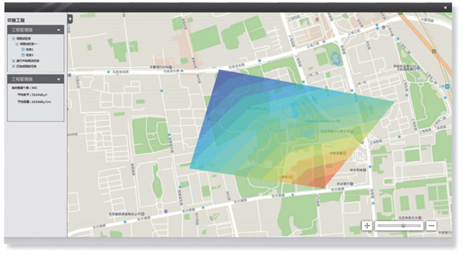Introduction
With the improvement of domestic economic levels, the increasing perfection of transportation infrastructure, and the diversification of travel needs, vehicle travel has gradually become an indispensable part of people's daily lives. During long drives or rides, how to effectively utilize this time and make the journey less monotonous has become a common concern for many drivers and passengers. Against this backdrop, in-car broadcasting, as one of the primary sources of entertainment and information during travel, has become increasingly prominent.
With the continuous advancement of various technologies, the digitization of in-car broadcasting is also deepening, bringing significant changes to the travel experience. Digital in-car services will provide people with various conveniences and pleasures, not only achieving a significant improvement in listening quality but also realizing a leap forward in personalized and intelligent services.
1. Introduction to CDR Technology
CDR (China Digital Radio) is a domestically developed digital broadcasting technology in China. It employs advanced DRA+ encoding technology, enabling the transmission of more audio programs on the original analog FM broadcast frequency points while maintaining sound quality equivalent to existing FM. The CDR system consists of encoders, multiplexers, exciters, transmitters, and other equipment. Through digital processing of audio signals, it achieves comprehensive digitization of broadcast signals.
The main characteristics of CDR technology lie in its excellent audio processing, strong signal stability, and flexible adaptability. Using DRA+ encoding, it achieves high-quality compression and transmission of audio signals, maintaining broadcast sound quality standards. Simultaneously, CDR possesses excellent anti-interference capabilities, ensuring stable signal transmission in various environments. Furthermore, it supports diverse transmission modes, meeting various needs from wide coverage to high-speed mobile reception, demonstrating its strong flexibility and broad application prospects.
2. Current Status of CDR Technology in China
With the transition of broadcast technology from analog to digital, CDR (China Digital Radio) and its digital-analog simulcast with FM (Frequency Modulation broadcasting) represent a significant trend in the development of broadcast technology. To establish a digital sound broadcasting system suitable for China's national conditions and possessing independent intellectual property rights, the Science and Technology Department of the State Administration of Radio, Film, and Television (SARFT) formed the China Digital Radio (CDR) working group in 2011 to carry out independent R&D and innovation. In the following years, China successively released relevant industry standards such as the CDR FM band channel standard and multiplexing standard, providing a foundation for the promotion and application of CDR technology. In recent years, pilot construction and application of CDR/FM digital-analog simulcast have been successively carried out across China, achieving significant progress domestically.
As a crucial part of the broadcast digitization process, CDR/FM digital-analog simulcast technology transmits digital CDR signals and traditional FM analog signals simultaneously within the same frequency band, achieving a smooth transition and seamless connection of broadcast signals. This technology not only preserves the extensive coverage foundation of FM broadcasting but also fully utilizes the advantages of CDR technology, such as high sound quality and high efficiency, providing listeners with a superior audio experience. As the technology matures and application scenarios expand, CDR/FM digital-analog simulcast technology is gradually becoming a key driver for the transformation and upgrading of the broadcasting industry, propelling broadcasting towards a more digital and intelligent direction. Simultaneously, government policy support and close cooperation throughout the industry chain provide strong guarantees for the rapid development of CDR/FM simulcast technology.
3. Testing CDR/FM Broadcast Signals
With the digitization of in-car systems, broadcast transmitters, as key equipment for in-vehicle audio transmission, also face the challenge of technological innovation. To ensure seamless integration and efficient transmission of high-quality digital signals for in-vehicle broadcasting, transmitters must possess CDR (China Digital Radio) generation capabilities to support this advanced digital broadcast standard. With the rapid expansion of the domestic in-car market and increasing user demands for audio quality, broadcast transmitters need not only to meet basic signal transmission requirements but also to achieve leaps in performance regarding stability, anti-interference capabilities, coverage range, and more. Concurrently, transmitter testing and routine maintenance are indispensable links in ensuring the stable operation of the broadcast system.
As broadcast technology continues to advance and in-car digitization accelerates, transmitters, being the core equipment for broadcast signal transmission, have performance and stability that directly impact the quality and coverage of broadcast services. Therefore, it is essential to use professional equipment to test the functions and performance of transmitters, ensuring all functions operate normally and performance meets required standards, thereby guaranteeing the continuous and stable output of high-quality signals.
Secondly, the signal reception quality at the receiving end is equally important, as it directly affects the listener's final experience. Therefore, a professional signal reception testing device is also needed at this stage. By detecting indicators such as signal strength and audio clarity, potential problems can be identified and resolved, optimizing the listener's experience and enhancing satisfaction.
Finally, coverage testing is essential. Testing helps evaluate whether the signal coverage meets expectations, allowing for adjustments to transmission strategies to ensure broadcast signals cover wider areas, bringing quality broadcast services to more listeners.
4. Doewe Solution
For the CDR/FM digital-analog simulcast era, Beijing Doewe Technologies Co., Ltd. provides a series of broadcast signal testing solutions. Whether for transmitter performance, signal reception quality, or signal coverage effectiveness, these solutions enable comprehensive testing of various broadcast signal indicators, thereby optimizing the listener's experience.
1、Broadcast Modulation Analyzer RWC2500A Plus
The RWC2500A Plus is a professional broadcast modulation analyzer primarily used for AM/FM transmitter testing. As a single unit, it can comprehensively test RF parameters, modulation performance, and audio layer metrics.
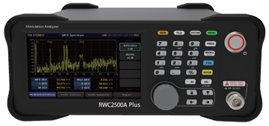
The device can demodulate AM/FM (mono and stereo) with high precision in real-time. It can test carrier power, frequency deviation, AM modulation depth, FM frequency deviation, and pilot signal-related parameters. The device supports real-time output of the demodulated audio signal. It can be configured for audio generation, outputting baseband audio signals, and supports independent level and frequency settings for left and right channels. It features both digital (balanced) and analog (balanced and unbalanced) audio output interfaces. The device has audio analysis capabilities, analyzing the demodulated baseband audio signal, supporting frequency domain and time domain analysis, and displaying audio spectrum and waveform. Based on its multifunctional combination, the RWC2500A Plus can directly analyze key transmitter indicators, such as carrier parameters, audio distortion, audio signal-to-noise ratio (SNR), audio frequency response, and stereo audio separation. A single instrument meets the complete testing requirements for broadcast transmitters in the broadcasting industry.
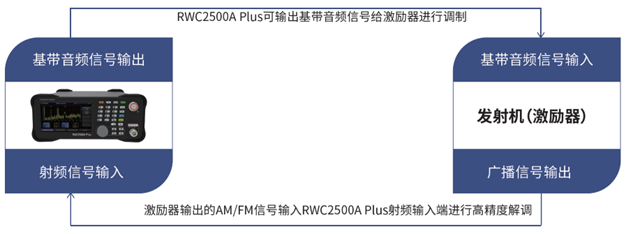
2、Broadcast Tester FMH
The portable Broadcast Tester FMH is specifically designed for broadcast signal testing. Its test architecture, based on globally standard RF hardware fundamentals, ensures its professionalism. The FMH supports not only traditional AM and FM testing and monitoring but also detailed testing of China's Digital Audio Broadcast (CDR) signals.
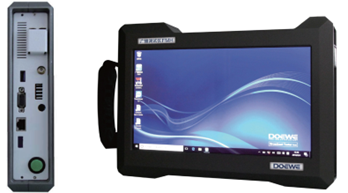
For CDR testing, the FMH can test level/constellation diagram/MER (Modulation Error Ratio), and IQ characteristics. Its high MER testing capability places it directly in the forefront of instruments for transmitter testing, with a comprehensive real-time MER testing capability reaching 45 dB (for pure digital CDR). It can subdivide and test MER parameters at all levels involved in the standard, display MER curves for individual subcarriers, and test IQ distortion and amplitude-frequency response. For field testing, the FMH boasts industry-leading receiver sensitivity, ensuring capture and analysis of low-level signals. Simultaneously, the FMH features a spectrum waterfall display and spectrum monitoring functions and can record IQ data for later playback and testing. These functional characteristics undoubtedly make the FMH a multi-featured instrument, bringing significant additional value to transmitter station engineers.
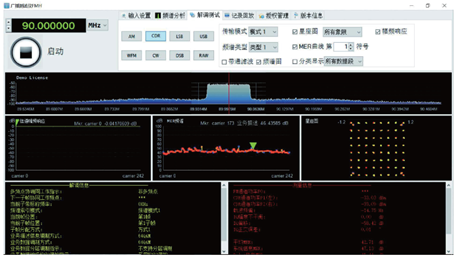
For pure CDR digital signals, the FMH possesses real-time MER testing capability with high MER measurement parameters, fully satisfying transmitter performance testing. Particularly importantly, the FMH can simultaneously test the power of the CDR upper and lower sidebands in real-time.
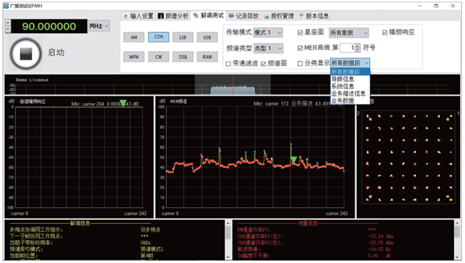
For scenarios where CDR and FM signals are simulcast, general analyzers can only perform spectrum analysis. The FMH features a dedicated filter module, allowing it to continue demodulating the CDR signal and observing channel parameters while performing spectrum analysis. It can also test MER. Despite the strong interference from the FM signal, the FMH can still maximize the demodulation of the constellation diagram and provide an MER value for comparative testing.
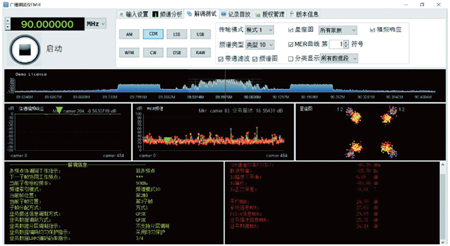
3、Field Strength Coverage Test System BroadCMS Plus
The Field Strength Coverage Test System BroadCMS comprehensively supports AM, FM, and CDR signal integrated field strength coverage drive testing. The system is configured with drive test platform software, a GPS reception system, and a map solution, enabling the drawing of point and line trajectories and performing 2D map coverage effect evaluation.
BroadCMS can be combined with the Broadcast Modulation Analyzer RWC2500A Plus or the Broadcast Tester FMH, used alongside professional receiving antennas and precision transmission cables. It supports secondary integration with industry-leading broadcast and television test instruments.
The main functions of the field strength coverage test system are as follows:
• The coverage test software can display signal level parameters and perform strength statistics. It can automatically calculate the field strength value in dBμV/m based on user-input antenna factors and cable losses.;
• The coverage test software automatically saves test information, including signal strength, longitude, and latitude;
• The coverage test software features GPS positioning and real-time communication with the test host, providing system status during mobile testing;
• The coverage test software supports both online and offline map working modes, features map caching, and supports maps such as Google and Bing;
• It can display the current test position and related test data in real-time on the map window;
• Test data can be exported as Google Earth files;
• The test process can be replayed based on the test path and data;
• It features coverage analysis capabilities, enabling the generation of areal coverage analysis maps based on test data;
• It can automatically generate test reports in WORD format;
• Threshold settings can be customized;
• It has statistical functions to view the data distribution of current or completed tests;
• It can export data to Excel.
For marking transmitter tower information:
Select the "Mark Transmitter Tower" tool in the navigation bar. Left-click the mouse on the map at the location where a transmitter tower needs to be marked. A transmitter tower information dialog box will pop up.
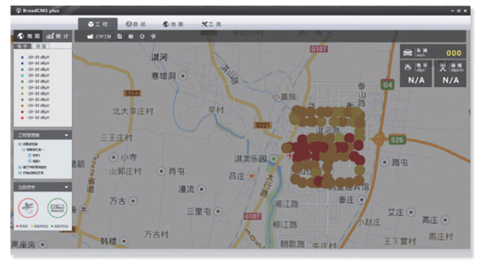
BroadCMS supports automatic report generation
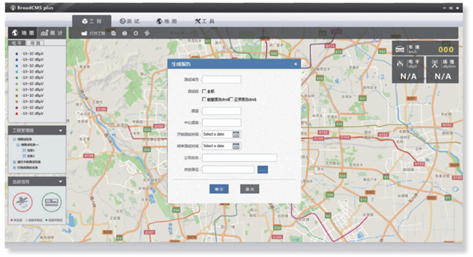
Supports coverage diagram function to illustrate signal coverage quality
